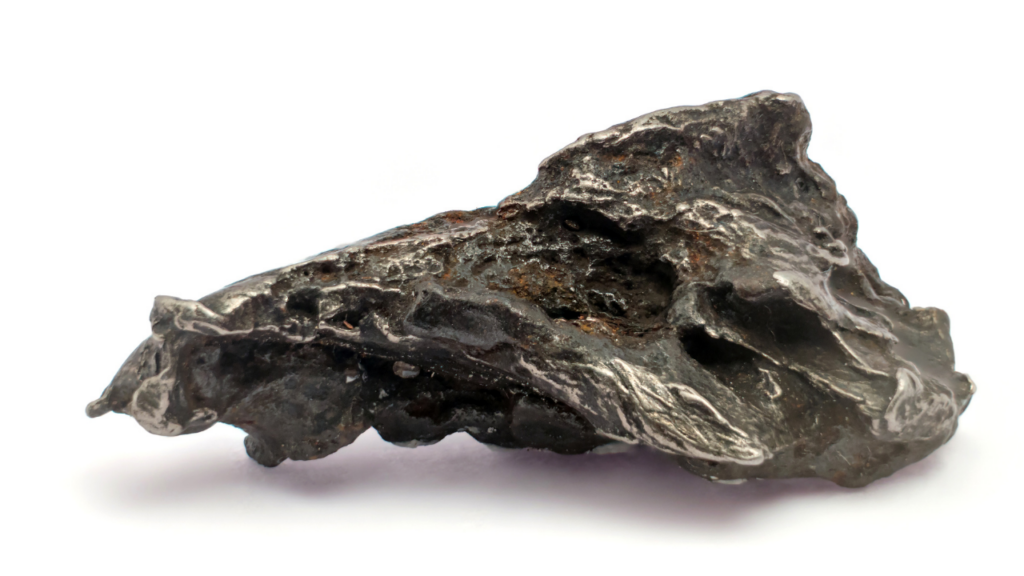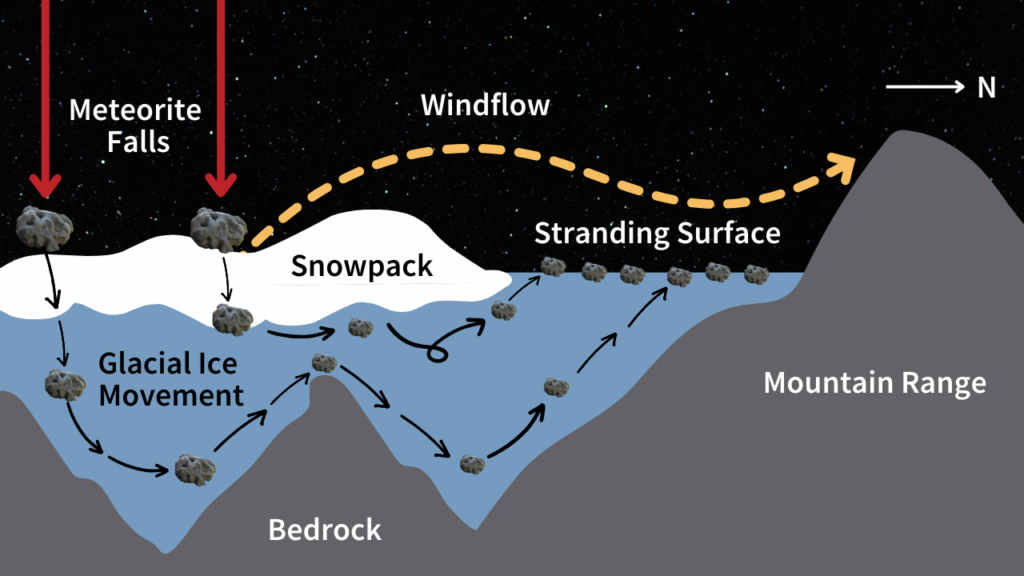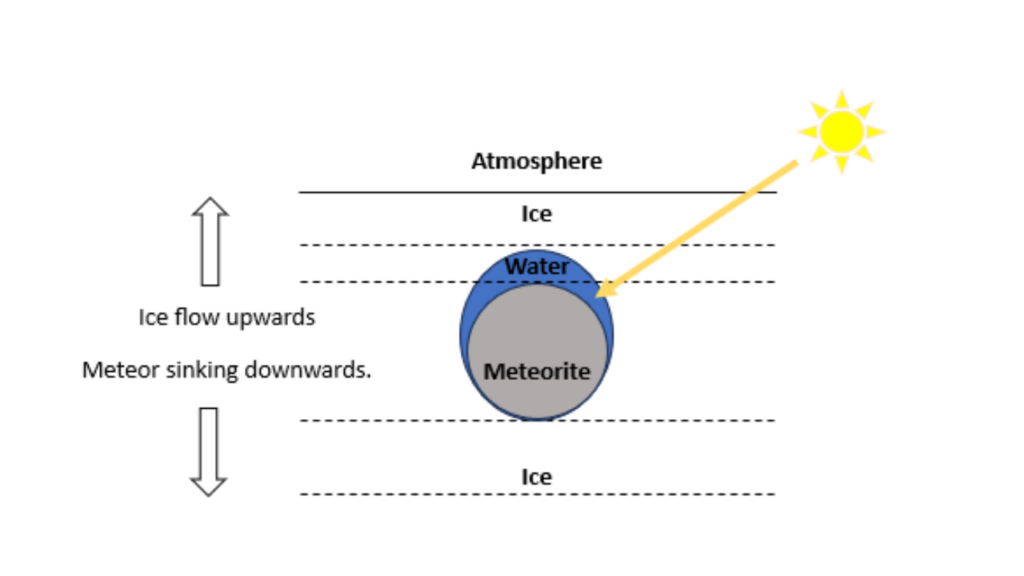
October 4, 2023
Meteorites fall across Earth almost every day. These small pieces of space rock break off bigger objects such as comets, asteroids or meteoroids and travel through space before passing through Earth’s atmosphere and landing on its surface. Antarctica is a known hot spot for collecting meteorites. However, scientists were baffled by the discrepancy in meteorite classes collected in the icy region for a long time. The number of iron-containing meteorites collected in Antarctica was significantly lower than the rest of the planet.
A groundbreaking study published in Nature Communications by researchers at the University of Manchester caught news headlines. It proposed that Antarctica lacks iron-containing meteorites due to their high thermal conductivity.
The model developed by researchers suggests that sub-layers of ice contain a distribution of meteorites with high thermal conductivities. If accessed, this layer would significantly increase the Antarctic meteorite library and provide critical information about our solar system.

Figure 1. Picture of Meteorite shrapnel.
Antarctica is a significant location for meteorite collection, accounting for 66.3% of all meteorites collected across the planet. Located in the southernmost region of the earth, Antarctica has favourable environmental conditions for both the preservation and retrieval of meteorites: the frigid cold and lack of humidity help to preserve the rocks’ structure. At the same time, the reduced number of earth rocks in this icy continent makes spotting them much easier. Statistically, most meteorites fall into the ocean since they comprise 70% of the earth’s surface.
When meteorites fall on the icy surface of the Antarctic, they typically sink and become embedded in the ice sheet. Snow accumulates, compacts, and turns to ice, creating a gravitational force beneath the surface. The glacial ice movement and wind flow act as a giant conveyor belt carrying the embedded meteorites to its surface. These areas of exposed meteorites are known as “Meteorite Stranding Zones” (MSZ’s). Most meteorites are found on blue ice, which lacks a covering layer of snow. The lack of cover exposes the meteorites to the surface; field workers easily spot them from there.

Figure 2. The formation of meteorite stranding surfaces
Despite Antarctica being a treasure trove for finding meteorites, scientists noted a significant difference in the meteorites they found within the icy glaciers compared with others across the rest of the planet. Meteorite collection data revealed the proportion of iron-containing meteorites recovered from Antarctica was significantly lower than in the rest of the world, suggesting one or more physical mechanisms are responsible for the apparent shortfall in iron-based meteorites.
Evatt et al., (2016) hypothesized that the under-representation of iron-containing meteorites in Antarctica is caused by solar energy penetrating the clear ice of the MSZ’s. It was suggested that as the meteorites move closer to the ice surface where collection occurs, they gain solar energy and heat up. Iron-containing meteorites have higher thermal conductivities than other meteorite classes and tend to sink faster than the ice can push them up, resulting in iron-based meteorites becoming “trapped” within the ice and very few collected in these regions.
They set out to prove their predictions through laboratory testing and mathematical modelling. In the lab, two roughly the same size meteorites, an achondrite and an ordinary chondrite (one composed of iron and the other iron-free), were encased in ice blocks. A strong lamp was then shone on each meteorite to mimic the sun shining. The rate at which they melted the surrounding ice and sunk was recorded as they heated.

Figure 3. Visual representation of the boundaries and geometry of mathematical model
To relate the laboratory experiments to the Antarctic setting, a mathematical energy balance model was developed by Evatt et al., (2016). Close alignment of the model and laboratory results would prove their hypothesis. The energy balance model considered all necessary competing energy fluxes, including heat conduction within the ice, meteorite and surrounding melt-water layers, and energy to and from ice-phase transitions. To compare the progress between the two different meteorites, thermal conductivities of 25 W/m·K and 1.5 W/m·K were estimated for achondrite and chondrite samples, respectively.
Under laboratory conditions, both meteorite classes proved able to warm up the surrounding ice and sink. It was found that the average speed of the iron meteorite (2.4 mm/hr) was almost double that of the non-iron-containing meteorite (1.5 mm/hr).
The results obtained from the mathematical model closely agreed with laboratory tests and allowed researchers to apply the model with high confidence. The results demonstrated the predicted divergence between the meteorite classes. The model confirmed that meteorites with thermal conductivities higher than around 4 W/m·K will remain trapped within the ice, whereas meteorites with lower thermal conductivity will emerge onto the surface.
The energy balance model also allowed researchers to rule out other extraneous variables that might account for the underrepresentation of iron-containing meteorites, including meteorite surface albedo (the fraction of sunlight reflected by its surface) and mass density—further confirming their hypothesis that the lack of iron-containing meteorites found in Antarctica is due to solar energy and their high thermal conductivities.
An implication of these results includes the existence of a distributed layer of iron-based meteorites beneath the surface of MSZ’s. Each new iron-containing meteorite that is recovered has the potential to fill critical gaps in our understanding of how different meteorites are related to one another and information on the chemical makeup of the solar nebulas from which they were ejected.
This study is an exciting first step in understanding why the composition of meteorites collected in Antarctica differs from other areas of the world. Evatt et al., used a combination of laboratory testing and mathematical modelling to confirm their hypothesis that the lack of iron-containing meteorites is due to their high thermal conductivities.
Along with the value in answering this puzzling scientific question, the motivation for accessing a rich layer of iron-based meteorites below the surface of Antarctica’s MSZ’s is clear. Revealing these ancient meteorites may uncover critical information about early solar system formation processes and the diversity of planetesimals that were present with it.
To read more about this interesting phenomenon or the methods used in this study, please visit:
http://www.nature.com/ncomms/2016/160216/ncomms10679/full/ncomms10679.html
Antarctica has favourable environmental conditions for both the preservation and retrieval of meteorites: the frigid cold and lack of humidity help to preserve the rocks’ structure. In comparison, the reduced number of earth rocks in this icy continent makes spotting much more effortless.
As meteorites get transported closer to the surface of meteorite stranding zones, solar energy penetrates the clear ice, heating the meteorite. The heat generated can melt the surrounding ice and cause the meteorite to sink further. Iron-containing meteorites have high thermal conductivities, causing them to sink faster than other meteorite classes. The high thermal conductivity enables these meteorites to sink much faster than glacial transportation can move them up, causing them to become trapped within the ice.
Researchers conducted a laboratory experiment to test their hypothesis, where they enclosed two meteorites of different classes, one iron-containing and the other not, in blocks of ice. They then subjected the meteorites to a bright light to mimic the Antarctic sun. The rate at which the surrounding ice melted and the meteorites sank was then measured and compared to their respective thermal conductivities. They also developed a mathematical model to prove their hypothesis further.
An implication of these results includes the existence of a distributed layer of iron-based meteorites beneath the surface of MSZ’s. Each new iron-containing meteorite that is recovered has the potential to fill critical gaps in our understanding of how different meteorites are related to one another and information on the chemical makeup of the solar nebulas from which they were ejected.
References
Evatt, G. W., Coughlan, M. J., Joy, K. H., Smedley, A. R., Connolly, P. J., & Abrahams, I. D. (2016). A potential hidden layer of meteorites below the ice surface of Antarctica. Nature Communications, 7(1). https://doi.org/10.1038/ncomms10679
Tollenaar, V., Zekollari, H., Lhermitte, S., Tax, D. M. J., Debaille, V., Goderis, S., Claeys, P., & Pattyn, F. (2022). Unexplored Antarctic meteorite collection sites revealed through Machine Learning. Science Advances, 8(4). https://doi.org/10.1126/sciadv.abj8138
————